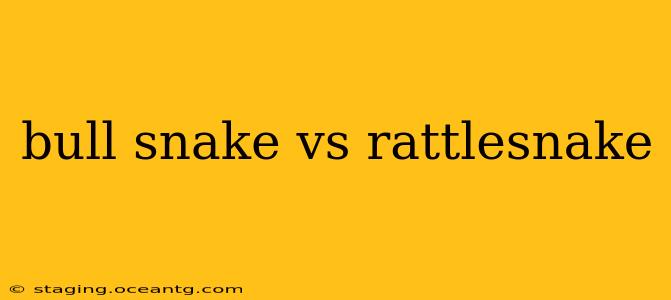The question, "Bull snake vs. rattlesnake," often arises from encounters in similar habitats and a shared, albeit vastly different, presence in the wild. Understanding their differences is crucial for safety and appreciating the unique roles these snakes play in their ecosystems. This comparison will delve into their physical characteristics, behavior, venom, and more, answering common questions people have about these fascinating reptiles.
What are the key physical differences between a bull snake and a rattlesnake?
Bull snakes and rattlesnakes, while both belonging to the Colubridae family (though rattlesnakes are in the subfamily Crotalinae), exhibit distinct physical characteristics. Bull snakes are generally larger and heavier than rattlesnakes of comparable length. They lack the defining feature of rattlesnakes: the rattle at the end of their tail. Instead, bull snakes are identified by their variable coloration – often ranging from light brown to dark brown or even black – and their smooth, non-keeled scales. Rattlesnakes, on the other hand, boast keeled scales (scales with ridges) and possess triangular heads, a direct result of their powerful jaw muscles needed for envenomation. Their coloration is also quite variable, depending on the species.
Are bull snakes venomous?
No, bull snakes are non-venomous. They are constrictors, meaning they kill their prey by squeezing them tightly until they suffocate. This is a stark contrast to rattlesnakes, which employ venom to subdue their victims. This crucial difference underscores the importance of accurate identification: while a bull snake might appear threatening due to its size, it poses no venom threat to humans.
How can I tell the difference between a bull snake and a rattlesnake?
Distinguishing between bull snakes and rattlesnakes hinges on a few key features:
- Presence of a rattle: The most obvious difference. Rattlesnakes have a rattle; bull snakes do not.
- Head shape: Rattlesnakes possess a triangular head, while bull snakes have a more rounded or elliptical head.
- Scales: Rattlesnakes have keeled scales, whereas bull snakes have smooth scales.
- Body size and build: While size can vary, bull snakes tend to be larger and more robust than rattlesnakes of similar length.
What is the habitat of each snake?
Both bull snakes and rattlesnakes inhabit a range of environments, but their preferences can differ. Bull snakes are adaptable and are found in various habitats including grasslands, deserts, and rocky areas. They are often found near rodent burrows, their primary food source. Rattlesnakes, too, are adaptable but often prefer rocky areas, deserts, and woodlands. The specific habitat will depend on the species of rattlesnake.
Are bull snakes aggressive?
Bull snakes, while large, are generally not aggressive. They are more likely to flee when confronted than to attack. However, like any wild animal, they will defend themselves if cornered or feel threatened. A cornered bull snake might strike, but this is purely defensive behavior. Remember, they are non-venomous, so while a bite might be painful, it's not medically dangerous.
Which snake is more dangerous to humans?
Clearly, rattlesnakes are far more dangerous to humans due to their venom. While a bull snake bite is unlikely to cause significant harm, a rattlesnake bite requires immediate medical attention. The venom's severity varies among rattlesnake species, but all pose a serious health risk.
What do bull snakes and rattlesnakes eat?
Both snakes are important parts of their ecosystems, primarily controlling rodent populations. Bull snakes feed on a variety of rodents, small birds, and reptiles. Rattlesnakes also consume rodents, along with other small mammals, birds, and reptiles. Their diet is largely determined by the size and availability of prey in their environment.
This comparison provides a clearer understanding of the differences between bull snakes and rattlesnakes. Accurate identification is vital for ensuring safety and appreciating the unique ecological roles these fascinating reptiles play. Remember, always maintain a safe distance from any wild snake and never attempt to handle them.
